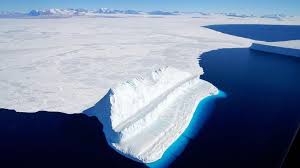Scientists from UC Irvine Discover Quick Melting Below Antarctica’s Thwaites Glacier
Scientists from the University of California, Irvine (UCI) and other glaciologists have discovered indications of considerable melting beneath West Antarctica’s Thwaites Glacier. Their study, which was published in the Proceedings of the National Academy of Sciences, found that warm, high-pressure seawater had seeped several kilometers beneath the grounded ice using high-resolution satellite radar data.
According to the study, “vigorous melting” is occurring at an alarming rate due to widespread contact between the ocean and the underside of the glacier, a phenomena that has been witnessed throughout Greenland and Antarctica. The existing predictions for the rise in global sea level may need to be reevaluated in light of this rapid ice loss.
The ICEYE constellation of satellites provided the data used by the research team, which was headed by Professor Eric Rignot of Earth System Science. These satellites continuously track changes on Earth’s surface using InSAR (interferometer synthetic aperture radar) technology. The ICEYE constellation can produce extremely comprehensive data about the rise, fall, and bending of the Thwaites Glacier by taking numerous passes over a given area.
Citing the ICEYE data as evidence of its importance, Professor Rignot said, “These ICEYE data provided a long-time series of daily observations closely conforming to tidal cycles.” Through constant observation, the scientists were able to see how the glacier responded dynamically to tidal changes, which gave them important new understanding of how seawater and the ice base interact.
The research findings indicate that warm seawater can seep beneath the Thwaites Glacier, which is a worrying discovery. This saltwater builds up and presses against the ice sheet above it, along with freshwater generated by geothermal heat flow and friction at the ice base. “Seawater coming in at the base of the ice sheet…has to flow somewhere,” said Professor Rignot. The confined water eventually builds up enough pressure to lift the glacier as it searches for pathways or gathers in cavities. In certain places, he added, “the water is almost at the pressure of the overlying ice, so just a little more pressure is needed to push up the ice.”
There are two effects of this pressure increase. First, the higher ice sheet is more prone to calving and cracks, which can result in the large-scale ice chunks breaking off and raising the sea level. Secondly, the pressurization causes even more seawater to seep into the glacier’s base, hastening the melting process even more.
Understanding the intricate interactions between Antarctica’s glaciers and the surrounding ocean is crucial, as the research lead by UCI emphasizes. Particularly important is Thwaites Glacier, sometimes known as the “Doomsday Glacier” because of its propensity for catastrophic ice loss. A cascading collapse might cause adjacent glaciers to become unstable and significantly increase sea levels.
The present study has limitations, which the researchers have acknowledged. Although the high-resolution satellite data offers insightful information, actual measurements of the water pressure beneath the Thwaites Glacier are still difficult to do. In order to gather more accurate data on water pressure and temperature, future research projects may require putting devices closer to the ice base.
Professor Rignot is still upbeat about how their discoveries might be applied. “The project helped him and his colleagues develop a better understanding of the behavior of seawater on undersides of Thwaites Glacier.” With a better knowledge, more precise ice sheet models can be created, which will result in more accurate sea level rise predictions in the future.
The battle against climate change depends on our capacity to foresee its effects with sufficient accuracy. The Thwaites Glacier research conducted by the UCI team serves as a sobering reminder of the urgent necessity for ongoing scientific investigation and cross-national cooperation to address this global issue.



